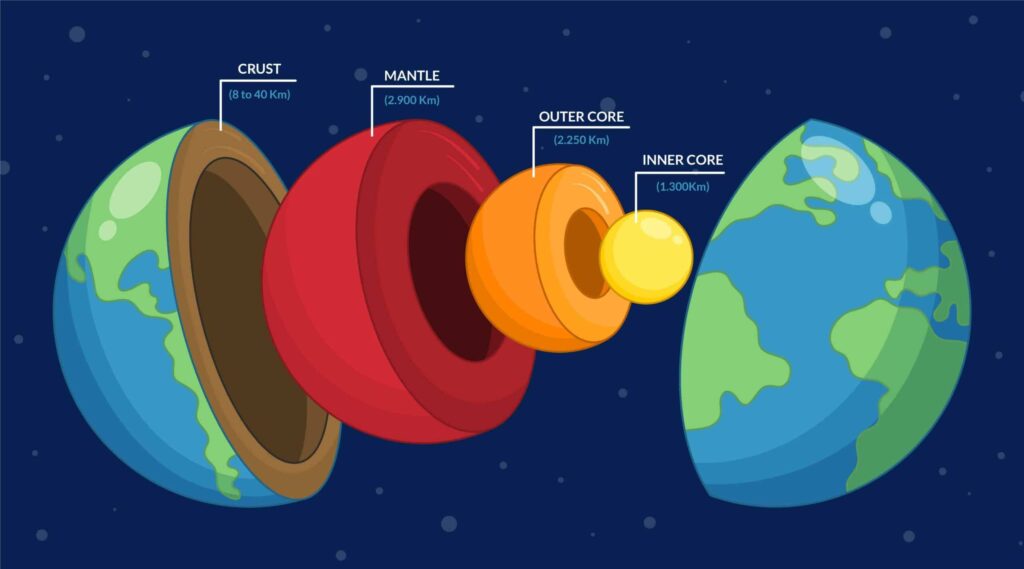The Earth, our home, is a complex and layered sphere, harboring mysteries within its depths that have fascinated scientists and explorers for centuries. At its surface, we observe the familiar features of land and water, but beneath lies a hidden world of immense pressure, heat, and geological activity. This layered structure, composed of the crust, mantle, outer core, and inner core, forms the foundation of Earth’s dynamic processes and shapes the environments we inhabit.
Earth’s crust, the thin outermost layer, is where we reside, comprising solid rocks and continents that support life as we know it. Beneath the crust lies the mantle, a semi-solid region of hot, flowing rock that extends thousands of kilometers downward. This layer plays a crucial role in driving tectonic activity, fueling volcanic eruptions, and circulating heat throughout the planet. More content like this on our homepage.
What is Earth’s Outer Core?

Definition and Composition
As I delve deeper into the inner workings of our planet, I’m drawn to unraveling the mysteries surrounding Earth’s outer core. Comprising primarily molten iron and nickel, the outer core is a fluid layer that lies beneath the solid mantle, extending from depths of about 2,900 kilometers to approximately 5,150 kilometers beneath the Earth’s surface. Its composition, predominantly iron and nickel, mirrors that of the inner core, albeit in a molten state due to the extreme temperatures and pressures found at these depths.
This molten composition gives the outer core its unique properties, including its ability to conduct electricity, which is essential for generating Earth’s magnetic field. The intense heat within the outer core keeps its temperature at around 4,000 to 5,000 degrees Celsius, comparable to the surface of the sun. Despite its extreme conditions, scientists have developed various theories and models to understand the behavior and dynamics of this crucial layer, shedding light on its role in shaping Earth’s geological processes.
Location within Earth’s Layers
Positioned between the solid inner core and the semi-fluid mantle, the outer core occupies a central role in Earth’s layered structure. Its location at the heart of our planet places it at the forefront of geological activity, where the intense heat and pressure drive convective currents and generate the magnetic fields that envelop Earth. This strategic position allows the outer core to interact dynamically with both the solid inner core and the flowing mantle, influencing the planet’s overall behavior and evolution over geological time scales.
Understanding the precise location and boundaries of the outer core within Earth’s layers is crucial for deciphering its complex dynamics and unraveling the mysteries of our planet’s interior. Through innovative scientific techniques such as seismic imaging and geomagnetic studies, researchers continue to refine our knowledge of this hidden realm, offering valuable insights into Earth’s past, present, and future.
Properties of the Outer Core

State of Matter and Temperature
Exploring the outer core’s properties unveils a realm of extreme conditions and remarkable behavior. At the heart of Earth, the outer core exists in a state of molten fluidity, characterized by its ability to flow freely due to the intense heat and pressure exerted at depths exceeding 2,900 kilometers. With temperatures reaching staggering heights of 4,000 to 5,000 degrees Celsius, this fiery domain rivals the surface of the sun in its scorching intensity.
The molten state of the outer core is essential for its dynamic behavior, facilitating convective currents that drive heat transfer and geological processes within Earth’s interior. This fluidity also enables the outer core to undergo complex movements and interactions, influencing the planet’s magnetic field and contributing to its overall dynamism.
Density and Pressure
As I delve deeper into the outer core’s properties, I encounter the formidable forces of density and pressure that define this subterranean realm. With densities averaging around 9 to 12 grams per cubic centimeter—roughly twice that of the overlying mantle—the outer core exerts immense pressure on its surrounding environment. The sheer weight of the overlying rock and mantle imposes crushing forces on the molten iron-nickel alloy, compressing it into a dense, fluid mass that fills the central regions of our planet.
These extreme pressures play a crucial role in maintaining the outer core’s molten state, preventing it from solidifying despite the intense temperatures encountered at such depths. Moreover, the high density of the outer core contributes to its gravitational pull, influencing the distribution of mass within Earth and shaping the planet’s gravitational field.
Magnetic Field Generation
One of the most intriguing properties of the outer core is its ability to generate Earth’s magnetic field, a phenomenon that has captivated scientists for centuries. This magnetic field, which extends far beyond the planet’s surface into space, serves as a protective shield against solar winds and cosmic radiation, safeguarding life on Earth from harmful cosmic particles.
The process of magnetic field generation within the outer core arises from the complex interactions between convective currents of molten metal and the Earth’s rotation. As these currents flow and circulate within the outer core, they generate electric currents through a process known as the dynamo effect. These electric currents, in turn, produce magnetic fields that align with Earth’s axis of rotation, giving rise to the familiar north and south magnetic poles.
Interesting Facts About Earth’s Outer Core

The Discovery of the Outer Core
As I delve into the history of Earth’s exploration, I uncover the fascinating story behind the discovery of the outer core. The journey to understand Earth’s interior began centuries ago, with early thinkers pondering the nature of our planet’s composition and structure. However, it wasn’t until the early 20th century that groundbreaking seismic studies provided the first clues about the existence of the outer core.
In the early 1900s, seismic waves generated by earthquakes revealed unexpected patterns of reflection and refraction as they traveled through Earth’s interior. These anomalies led to the realization that Earth’s core consisted of distinct layers, including a solid inner core and a liquid outer core. This groundbreaking discovery revolutionized our understanding of Earth’s internal structure and laid the foundation for further exploration into the dynamics of the outer core.
Relationship with Earth’s Magnetic Poles
Another intriguing aspect of the outer core is its intimate relationship with Earth’s magnetic poles. The outer core plays a central role in generating and sustaining Earth’s magnetic field, which extends far beyond the planet’s surface and influences our daily lives in myriad ways. This magnetic field, often depicted as invisible lines of force emanating from the poles, serves as a navigational aid for animals, guides compass needles, and protects our atmosphere from harmful solar radiation.
The connection between the outer core and Earth’s magnetic poles lies in the process of magnetic field generation through the dynamo effect. As molten metal circulates within the outer core, it generates electric currents that produce magnetic fields aligned with Earth’s axis of rotation. These magnetic fields give rise to the geomagnetic poles, which approximately coincide with the geographic poles but may wander over time due to complex interactions within the outer core.
Theories on the Origin of Earth’s Magnetic Field
Exploring the mysteries of Earth’s magnetic field leads me to encounter various theories regarding its origin, each offering unique insights into the complex interplay of forces within the outer core. One prominent theory suggests that the magnetic field arises from the convective motion of molten metal within the outer core, driven by the heat released from Earth’s core and mantle.
Another intriguing hypothesis proposes that Earth’s magnetic field may have its roots in the planet’s formation and early history. According to this theory, the cooling and solidification of Earth’s core billions of years ago created a residual magnetic field, which has persisted to the present day through self-sustaining processes within the outer core.
Regardless of its origin, Earth’s magnetic field continues to intrigue scientists and inspire further exploration into the dynamics of the outer core. By unraveling the mysteries of this enigmatic realm, we gain valuable insights into the fundamental processes shaping our planet and the intricate connections between Earth’s interior and the world we inhabit.
